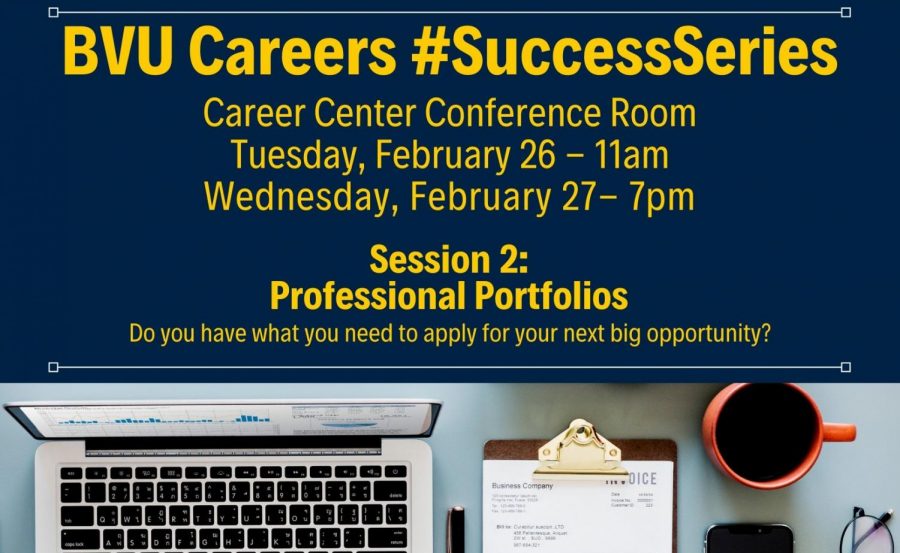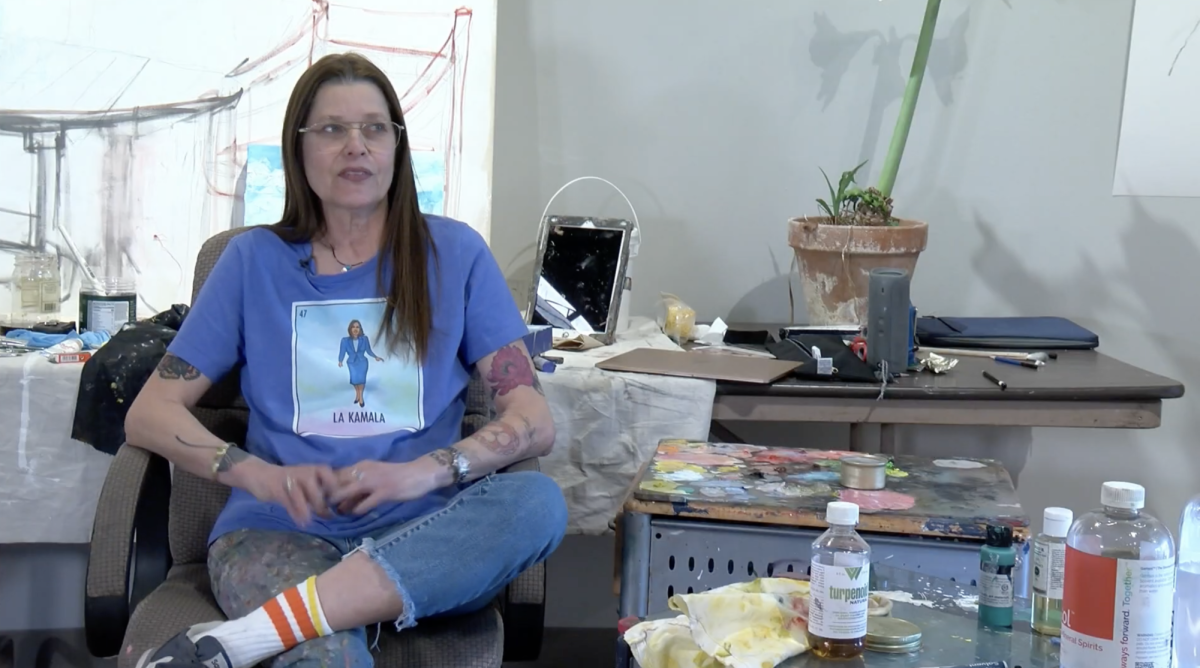Success Series: How to Build Your Professional Portfolio
March 7, 2019
A professional portfolio can single you out from other job applicants by showcasing your unique skills, experiences, and accomplishments to visually illustrate why you are the best candidate for the job. Kristi Davis, Assistant Director of Career and Personal Development, recently offered Buena Vista University students the opportunity to learn about what can set them apart from the competition through her Professional Portfolio session, a part of the Career and Personal Development office’s ongoing Success Series.
The first pieces of your professional portfolio that you should perfect are the resumé and cover letter. A curriculum vitae and e-portfolio are additional pieces to the puzzle that can benefit you when applying for jobs.
Your resumé should be a one to two-page summary of your relevant skills, education, and experience. Marketing yourself efficiently on your resumé is absolutely essential to even obtain an interview. Frequently, the people determining if you get an interview will not actually be interviewing you!
It’s vital that you communicate the potential value you will bring to the job and tailor your content to your audience successfully. You don’t want your resumé thrown out before you even get the chance at an interview!
Tips for tailoring your resume to be at its optimal potential include keeping it to one page. This makes the most important skill sets stand out more due to the concise editing you’ve put into this resumé. When you’re creating your resumé, a tip that I found helpful was to keep a running list of all of your accomplishments. You can then easily create a resumé for any job off of this list by taking the applicable skills or experience off the list and placing them strategically on your resumé per the job you’re aiming for.
Place the most critical categories first by keeping the job description in mind! Reverse chronological order of your experience is the best way to organize your resumé, because it will show what is the most recent experience and skills in your life. List ALL experiences that will benefit you in the job you are applying for. Quantification of information will also benefit you. An example of this is that if you’ve written for your school newspaper, quantify the number of articles that you’ve contributed to your best estimate.
Technicalities will show your professionalism and set you apart in submission of your resumé. Make sure that your email address shows who you are. If your email is [email protected], the employer will not only not be able to identify the email as yours, but the email itself will come across as extremely unprofessional. In addition, submitting your resumé as a PDF will ensure that its format is not scrambled as it is sent through the internet.
So, we’ve gone over everything you should do when assembling your resumé, but what shouldn’t you do? For one thing, you should absolutely not put your social media account links on your resumé. It is considered unprofessional, and chances are high that the employer will find these anyway. You should also not include high school involvement, because this is likely irrelevant when applying for jobs at this point in your life.
Job experience that has no relation to the job you are applying for is also unnecessary to put on your resumé. An employer that is considering you for a job in social media management is probably not going to care about the two summers you spent waitressing at Chili’s.
Be thorough in checking for typos on your resumé. According to the Career and Personal Development office’s information, 59% of employers toss out resumés because of a typo. This can make or break you when an employer is considering job applicants!
If your GPA is higher than 3.0, include it; if it’s below, leave it out. Obvious skills and job duties are also unnecessary when composing your resumé. “I worked at Hy-Vee in the bakery,” is not descriptive of what you can actually do. Yes, you had a job at the bakery. That simply tells the employer you didn’t get fired. But what skills did you actually learn to do in the bakery that will assist you in the job you’re applying for?
Never, ever use a template to organize your resumé. This will just cause future problems for you when you attempt to revamp it in the future. Other information that should not be placed on a resumé are your private financial information, your salary, or race/ethnicity. These may seem obvious, but Career and Personal development has seen this occur.
If you’re ready to reorganize your resumé, Career and Personal Development can set up an appointment with you to do so. They also have sample “star” resumés to reference when you’re creating your perfect resumé.
A question many ask is, “Do I even need a cover letter?” The answer is yes, you really do. Cover letters can differentiate you from other applicants because they provide an opportunity to discuss in detail your previous experiences and how these contribute to why you are an ideal candidate for the job you are applying for.
In a cover letter, do not make the common mistake of just regurgitating the information on your resumé. Show the employer your skill sets in detail, don’t just tell. Resumés are for hard skills such as the Adobe suite; cover letters are for elaboration about what you’ve done that sets you apart from others.
Now, what is a curriculum vitae? A curriculum vitae is a detailed overview of your education, qualifications, and previous experience. It is typically longer than two pages, and normally used when applying to academic teaching positions, research positions, and application to positions abroad. It’s also used when applying for grants, fellowships, and some administrative positions in colleges and universities.
When creating one of these, for example in applying for a teaching position, asking yourself specific questions and answering them will make it thorough and specific to you. In teaching, ask yourself what you believe about teaching and learning, as well as how it’s played out in your classroom experience. Also ask yourself how student identity and background make a difference in how you teach, and what you still struggle with in terms of teaching and student learning. Career and Personal Development can offer much more information about creating a curriculum vitae. Setting up an Outlook appointment is the perfect way to do so.
Before turning in each of these pieces for a job application, make sure you have someone read them over to make sure you avoid mistakes. You may miss mistakes you’ve potentially made when you read your resumé or cover letter a ton of times.
Thinking about creating an e-portfolio? This can be a fantastic addition to your professional portfolio, but only if you have the time to keep it updated.
“If you have a personal website, it’s like a puppy. You need to be feeding it all the time,” says Davis.
Davis recommends making the website crisp and easy to navigate. Especially if you have exceptional experience in website design, you should make the website easy to navigate with a clearly labeled menu. Broken links will create frustration for potential employers, so make sure that when you are utilizing this in showcasing your work that all pieces of the site are connected correctly.
Now, you’ve decided you have time to keep updating your e-portfolio. What needs to be on it? A homepage, headshot, any awards you’ve received, your resumé, and contact information should all be present on this site. Any standout work that you want to present to the employer should also be featured here.
If you do not have a headshot, Career and Personal Development offers free headshots! Keep an eye out for when these are offered via BVU News emails or their social media pages. To contact them for any appointments, send an Outlook appointment or shoot them an email.
The contact information and page links for Career and Personal Development are included below:
Email: [email protected]
Facebook: @BVUCareer
Twitter: @BVUCareerCenter
Instagram: @BVUCareers
Keep an eye out on these social media pages and in BVU News for announcements on future Success Series events!








